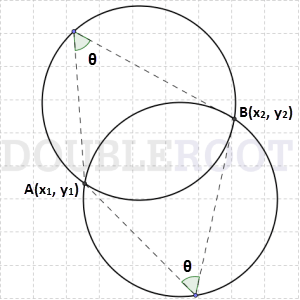This lesson will cover a couple of more equations to the circle.
Equation of a circle whose diameter’s end points are known
Let the end points be A(x1, y1) and B(x2, y2). There are two ways to find the equation. I’ll cover the boring one first.
Method 1
Using the section formula, we can find the centre of the circle: ((x1 + x2)/2, (y1 + y2)/2).
And using the distance formula, we can find the radius (i.e. AB/2) as \( \sqrt{(x_1-x_2)^2 + (y_1-y_2)^2} \) / 2.
Therefore the required equation is [x – (x1 + x2)/2]2 + [y – (y1 + y2)/2]2 = [(x1 – x2)2 + (y1 – y2)2]/4. A complicated looking equation!
Now to the interesting method.
Method 2
Recall that the diameter subtends a right angle at any point on the circumference. That is, if P(x, y) be any point on the circle, then the angle between the lines PA and PB will always be 90°.
In other words, the product of slopes of PA and PB will always be – 1. And we’ll use this relation to obtain the equation of the circle.
Slope of PA = (y – y1)/(x – x1); Slope of PB = (y – y2)/(x – x2)
Putting their product equal to –1, we get [(y – y1)/(x – x1)] x [(y – y2)/(x – x2)] = –1
On rearranging, we get a neat equation (x – x1)(x – x2) + (y – y1)(y – y2) = 0. Neat!
Equation of a circle whose chord subtends a given angle at the circumference
Let the end points of the chord be A(x1, y1) and B(x2, y2). And, let the chord AB subtend an angle θ at the circumference of the circle.
Let P(x, y) be any point on the circumference of the circle. Then ∠APB = θ. That is, the angle between PA and PB will be θ. Again, slope of PA = (y – y1)/(x – x1), and slope of PB = (y – y2)/(x – x2)
Using the expression for angle between two lines, we have tanθ = |[(y – y1)/(x – x1)] – [(y – y2)/(x – x2)]|/|1 + [(y – y1)(y – y2)]/[(x – x1) (x – x2)]|
And, that’s it! We obtain the equation of the circle as (x – x1)(x – x2) + (y – y1)(y – y2) = ± cotθ [(y – y1)(x – x2) – (y – y2)(x – x1)]
Notice that we obtain two equations, on removing the modulus sign. That’s because we have two possible circles as shown in the following figure.

Note that the previous equation was a special case of this equation, where θ was equal to 90°.
That’s all about equations (for now). A few more equations will be covered (much) later.
Lesson Summary
- Equation of a circle whose diameter’s end points are (x1, y1) and (x2, y2) is (x – x1)(x – x2) + (y – y1)(y – y2) = 0.
In the next lesson, I’ll cover a few examples related to the equations covered in this lesson.